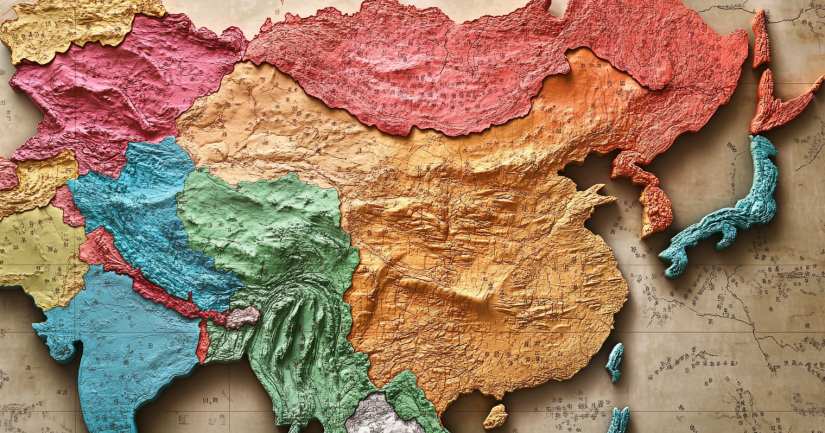
Discover the unique landscapes and stories of each region with our engaging China Provinces Quiz, Test Your Knowledge of China’s Regions and Their Unique Characteristics. The China Provinces Quiz challenges your understanding of the country’s 23 provinces, five autonomous regions, four municipalities, and two Special Administrative Regions (SARs). Each region has a distinct history, geography, and cultural identity, shaping China’s economic and political landscape. From the bustling metropolises of the east to the remote plateaus of the west, China’s provinces reflect the vast diversity of one of the world’s largest nations. This quiz will test your knowledge of their locations, capitals, economic strengths, and cultural significance.
China is divided into four types of administrative divisions:
- Provinces (省, shěng): 23 in total, including Sichuan, Guangdong, and Yunnan.
- Autonomous Regions (自治区, zìzhìqū): Five areas with significant ethnic minority populations, such as Tibet and Xinjiang.
- Municipalities (直辖市, zhíxiáshì): Four directly governed cities—Beijing, Shanghai, Tianjin, and Chongqing.
- Special Administrative Regions (特别行政区, tèbié xíngzhèngqū): Hong Kong and Macau, which operate under the “One Country, Two Systems” framework.
Learn more about the richness of China’s land and people with the captivating China Geography Quiz. Or, explore the heart of bustling metropolises in the China Cities Quiz.
It’s Time – China Provinces Quiz Awaits
The Political and Administrative Divisions of China
Understanding these divisions provides insight into China’s governance, regional identities, and political organization.
Eastern China: Economic Powerhouses and Cultural Centers
China’s eastern provinces drive the nation’s economy and global trade. Guangdong, home to Shenzhen and Guangzhou, is a major manufacturing hub, producing electronics, textiles, and machinery. Jiangsu, bordering Shanghai, has a strong economy built on technology and finance, while Zhejiang is famous for private entrepreneurship and e-commerce, hosting Alibaba’s headquarters in Hangzhou. Shandong, birthplace of Confucius, blends industrial strength with deep cultural roots. These coastal provinces fuel China’s rapid modernization while preserving centuries-old traditions.
Central China: Agricultural and Historical Heartland
The central provinces are rich in history and agriculture. Henan, known as the “Cradle of Chinese Civilization,” was home to ancient capitals like Luoyang and Kaifeng. Hubei, with its capital Wuhan, is a key transportation and industrial center. Hunan, birthplace of Mao Zedong, is famous for its spicy cuisine and stunning Zhangjiajie National Park. Anhui boasts the breathtaking Yellow Mountains (Huangshan) and deep literary traditions. These provinces balance economic growth with their role in preserving China’s cultural heritage.
Western China: Remote, Rugged, and Culturally Diverse
China’s western regions feature vast plateaus, deserts, and minority cultures. Tibet is the highest region in the world, home to the Potala Palace and Tibetan Buddhism. Xinjiang, China’s largest autonomous region, has a diverse population, including Uyghurs, Kazakhs, and Han Chinese. Qinghai is known for its high-altitude lakes and Tibetan influence, while Gansu is part of the ancient Silk Road, housing the famous Mogao Caves. These regions, though less populated, are crucial for China’s geopolitical and environmental strategies.
Northeast China: The Former Industrial Belt
China’s northeast, historically called Manchuria, includes Liaoning, Jilin, and Heilongjiang. Once the center of China’s heavy industry, these provinces have experienced economic restructuring. Harbin, in Heilongjiang, is famous for its Russian influence and Ice Festival, while Shenyang, in Liaoning, played a key role in China’s military history. The region’s cold climate and vast forests distinguish it from the rest of China.
Southern China: Tropical Climate and International Influence
Southern provinces enjoy warm weather and strong global connections. Yunnan, known for its diverse ethnic groups, borders Myanmar, Laos, and Vietnam. Guangxi, an autonomous region, is famous for its karst landscapes in Guilin. Hainan, China’s only tropical island province, is a growing tourism and free-trade zone. These provinces highlight China’s geographic and cultural diversity, blending tropical scenery with international trade links.
How Well Do You Know China’s Provinces?
China’s provinces reflect the country’s rich history, diverse cultures, and dynamic economy. From the highlands of Tibet to the financial hubs of the east, each region plays a crucial role in shaping China’s development. Take the China Provinces Quiz to test your knowledge of China’s geography, capitals, and regional identities!
China Quizzes – Explore the Wonders …
China Provinces – FAQ
Provinces are standard administrative units, while autonomous regions have a higher concentration of ethnic and enjoy more legislative rights and cultural autonomy. Tibet and Xinjiang are examples, showcasing distinct cultural identities of their major ethnic groups.
Provinces are key administrative units that aid in governance and economic management. They function under the central government but possess considerable authority over local economic policies and social programs. This setup allows for development strategies that align with regional needs.
China’s population distribution is uneven. Coastal provinces like Jiangsu and Zhejiang have high population densities due to industrialization and urbanization. In contrast, Qinghai and Tibet have lower densities because of challenging terrains and harsh climates.
For businesses entering the Chinese market, understanding the provincial structure is crucial. Each province has its own economic strengths, consumer behaviors, and regulatory conditions. Recognizing these differences helps businesses tailor strategies to meet local demands and navigate regulations effectively
